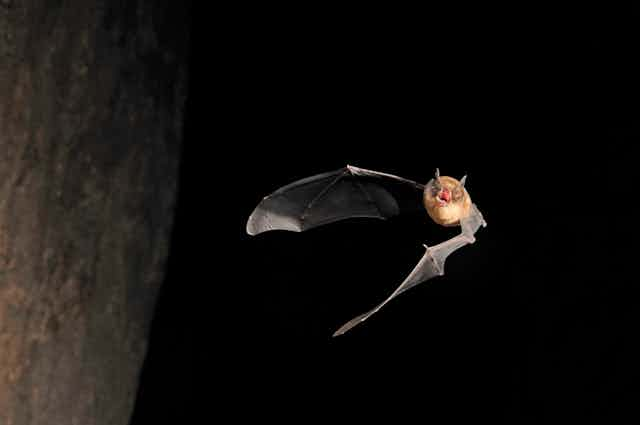A study released today in Nature shines some light on why bats produce high frequency calls – and why some squeak far higher than others.
Over the last four years I have been researching bats by monitoring their calls to gain an understanding of where they live and what types of habitat they need.
Indeed, scientists have been eavesdropping on the calls of echolocating bats for many years to learn about their habits.
There are more than 1,000 species of bat in the world, with some as small as a human thumb. What most people don’t realise is that each night hundreds of these fascinating creatures, from various species, could be flying around in your local area.
That’s because more than half of the world’s bat species, with the exception of flying foxes, use a highly specialised silent-method to see in the dark: echolocation.
Echolocation
Echolocation is a specialised way of using sound to create a 3D acoustical image to navigate. Although bats aren’t blind, echolocation helps them find their prey, which for some species is as small as a mosquito!
For the most part, ordinary people cannot hear bat echolocation calls because they are at a much higher frequency than humans are capable of hearing.
The exception is Australia’s White-striped Freetail Bat, which produces a very low frequency echolocation call just audible to the human ear.
For other bat species, scientists use a specialised device called a bat detector to eavesdrop on bat calls. Think of this as a radio that allows us to tune into different bat frequencies.
Bat species generally have a unique echolocation call frequency, although some species overlap in some areas.
We have known for some time that the smallest bats produce the highest frequency calls and that calls of one species can vary in different environments throughout their range.
But size alone can’t explain this higher pitch, because similar-sized birds and other mammals use much lower frequencies to communicate.
One existing theory is that high-frequency calls are used by bats to detect small prey, and the changes in calls between different environments are due to the way sound attenuates in different environments.
What the study found
The authors of today’s Nature study propose another explanation: the fact smaller bats typically have shorter heads and mouths forces them to produce high frequency calls to create an appropriate sound beam that enables them to navigate in their surrounding environment.

Beams of sound are produced by bats through either the mouth or nose when using echolocation. The study authors suggest smaller bats are constrained to higher frequencies to achieve a sufficiently directional beam, because sound beams broaden with the decreasing size of the emitter (the bat’s mouth).
This explains the relationship between bat size and echolocation call frequency.
And why is a directional sound beam so important? Because catching prey such as mosquitoes would be pretty hard if you couldn’t focus on such a tiny object!
Two commonly-occurring bat species in south-eastern Australia are good points of reference here: the Little Forest Bat, one of Australia’s smallest bats, and the Gould’s Wattled Bat.
The Little Forest Bat, weighing on average five grams, produces calls up to twice as high in frequency as the Gould’s Wattled Bat, weighing on average 15 grams.
Methodology
By placing six different bat species ranging in size in the same room and measuring all manner of sound attributes, the Nature researchers discovered all species produced similar sound beams despite differences in frequency and emitter size.
This, in turn, demonstrated that echolocation is dynamic and allows different species, regardless of body size, to adapt their calls in response to where they are and what they’re doing.
So what does this mean for scientists such as myself who eavesdrop on the calls of bats in the wee hours of the night?
Not only does it help explain why bats – like birds and frogs – differ in their calls; it helps explain why the calls of a single species may vary in different environments.
There is still so much about these tiny animals to discover and unravel!

